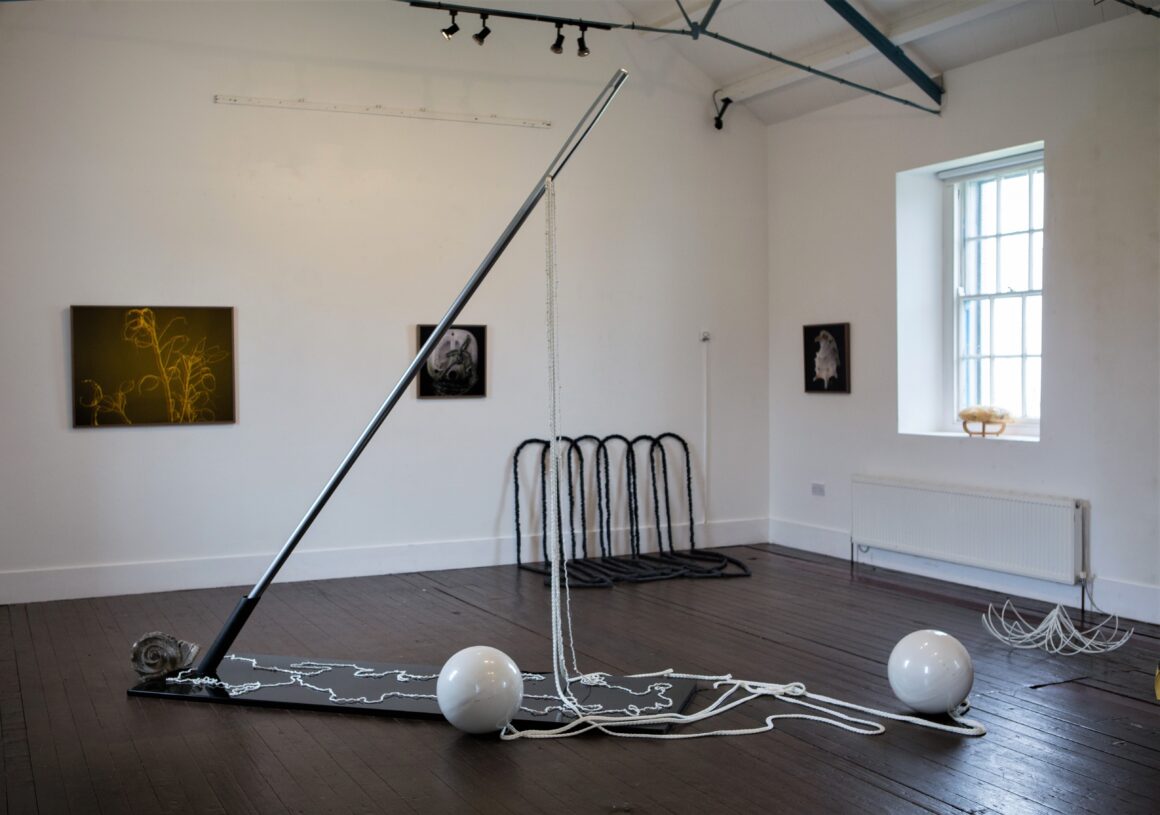Saldanha Gallery, Artlink, Fort Dunree
24 June – 23 July 2023
As observed by American writer, Ray Bradbury, in his dystopian novel, Fahrenheit 451: “We need not to be let alone. We need to be really bothered once in a while. How long is it since you were really bothered? About something important, about something real?”1 If we imagine the future, does it provide a sense of comfort or a feeling of terror that is nearly the stuff of Science Fiction? Looking directly at a crisis such as climate change does not seem to have produced the lessons that might bother society; it is necessary to take a more oblique perspective. Artists are ideally placed to probe important issues as their sensory approaches can often communicate to the individual on a different register. Art is immediate, subjective, and often jarring, with messages persisting in the mind longer than any news report.
Fiona Mulholland’s recent exhibition at Artlink, ‘In Search of Pearls & Future Fossils’, integrates natural materials and handcrafts while dwelling on reconfigurations of manmade materials and their detrimental impact on nature. The setting for this exhibition is deliberate, as Mulholland wanted to reference the coastal landscape as a dramatic and constantly evolving environment. Fort Dunree was strategically built in 1813 on a hillside overlooking the natural harbour of Lough Swilly. A military museum now occupies the original fort which leads to the Saldanha Gallery. The gallery is named after the HMS Saldanha that sheltered in Lough Swilly from a heavy storm in 1811 but was later wrecked off Fanad Head with over 250 lives lost. The fact that Artlink occupies the former military hospital building interestingly connects with Mulholland’s hopes that through meditation on detritus and found objects, we can consider avenues for renewal and repair of our surroundings.
The exhibition is laid out across three spaces, which lead the viewer from the present, through the past, and into the future. In the Mezzanine Gallery there are 17 works, including a series of small, square photographs, titled Land and Sea essence | Sites Unseen, which document the shore, plants and sea life, including dandelion seedpods, underlining a sense of ephemerality. For Mulholland, these photographs act as preparatory sketches for her larger photographs and sculptures, and are her means of “studying, listening and reflecting”. The artist notes that “it is an effort to capture the essence of things and conduct an almost microscopic study of their energy.”2

Presented along the glass corridor is the ‘Donegal Ringfort Series’, comprising eight pieces of digital embroidery on tweed and linen. These works feature individual mapped ringforts with a scale indicator, suspended against the glass backdrop within their embroidery hoops. This makes a direct connection between the archaeology of the past and the landscape around the fort. These works are felt by the artist to be “the perfect way to capture the theme of comfort and repair and a return to simpler ways, yet the contradiction is that they are machine-made rather than handmade.”3
The main gallery features extensive artworks, including wall-based photographs and silk hangings, combined with freestanding sculptural pieces, shelf-based works, and a vitrine of cast objects. There is a dramatic interplay between the thin grey metal roof beams of the exhibition space and the palette of the artworks below, suffused with natural light. The floorboards of the dark wooden floor subtly suggest a ship’s deck, with this maritime sense heightened through the placement of tweed lifejackets within the space. These are modelled on early twentieth-century lifejackets, with their tactility inviting viewers to lift them, put them on, and cuddle into the comfort of the material.
The main piece within the space is Pearls of Wisdom, Repair and Renewal (2023), which consists of a large threaded needle, made of powder-coated mild and stainless steel, extending at an angle from a Perspex and mild steel base. Threaded through the needle is fishing rope, with two white pearl-like buoys at the base, and a cartographic arrangement of threaded Styrofoam balls, resembling a string of pearls. This sculpture prompts reflection on how we can balance our fragile relationship with nature and how we might repair the damage through considered intervention. Returning to Bradbury’s Fahrenheit 451 – in which he warns that “our civilization is flinging itself to pieces. Stand back from the centrifuge” – we have the opportunity to act, but are we sufficiently bothered to take note?
Marianne O’Kane Boal is a writer and curator. She is currently completing her PhD at ATU Sligo.
1 Ray Bradbury, Fahrenheit 451 (New York: Ballantine Books, 1953)
2 Writer’s interview with the artist’, Fort Dunree, 8 July 2023.
3 Ibid.



